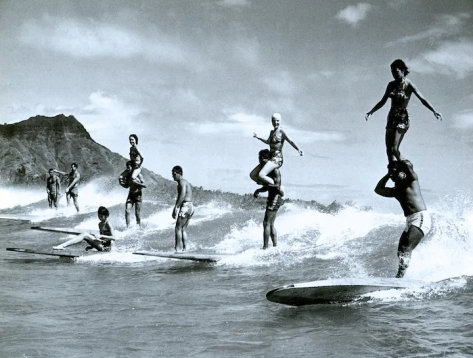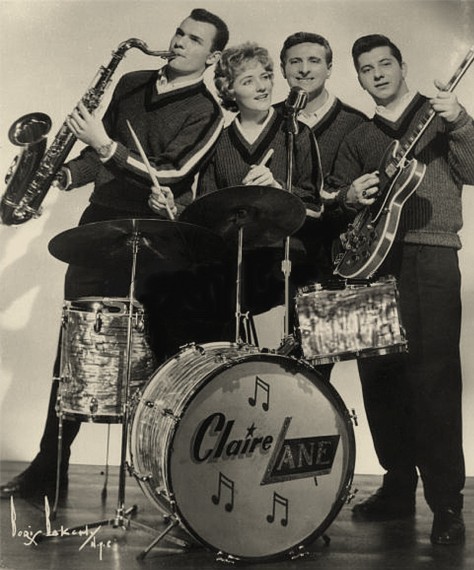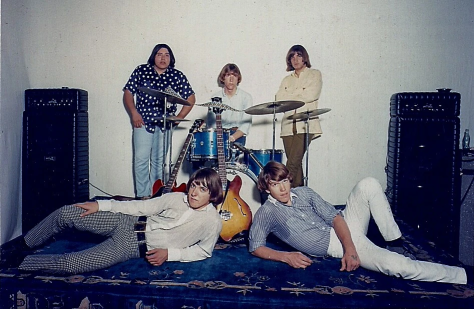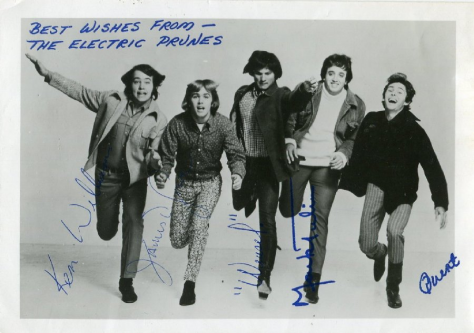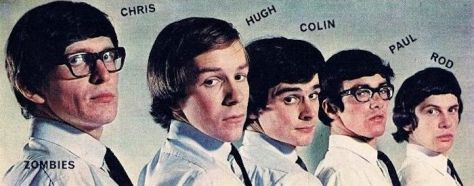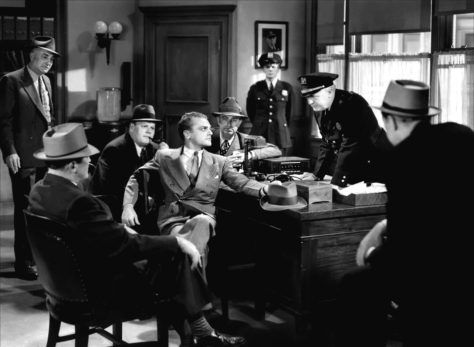
Despite this movie being made during the code, there’s no Public Enemy title card denouncing the lead’s behavior.
Angels with Dirty Faces is a well regarded 30s gangster movie that has some of the goods of what you’d expect from gangster flicks. It is violent for the time, but not so much by the standards of later films by those like Francis Ford Coppola and Martin Scorsese. Those newer movies benefit due to both entertainment value and often thematic value by not beating around the bush of what it means to be a gangster. However, the level of violence doesn’t matter too much if you got a good story. Dirty Faces is clever and has something to say, but at points wastes time and has loose subplots. It’s also not as subversive to films of its time as it can seem to some. Regardless, there is a fair amount to get out of it.
The performances are solid all around. Jerry Connolly, played by Pat O’Brien, does well being this almost silent observer whose subtle character arc tells us a lot about both the protagonist and what the movie is trying to say. The camera loves to give us nice shots of his face reacting to what’s going on, showing the impact of those that live around a criminal and how the audience supposedly should feel when various events unfold. A trope that comes up that is sometimes irritating is when a character says what is obviously the main point the writer is trying to convey. Here, that works better as Jerry seems to be realizing and coming to terms with certain things, like how criminals are revered by society. At one point, this is conveyed by him literally giving a speech. Ann Sheridan as Laury Martin is a weaker element. She has a purpose, but is treated as little more than a prize to be won and is barely even referenced. Jim Frazier, played by Humphrey Bogart, brings this fake confidence to every scene, like he’s trying to slide his way through the story undetected. Jim comes off as a bit of a loser, but that not only feeds into the message that being a gangster will only get you trouble, but it arguably feeds into one of the great themes of the film… Rocky Sullivan is unstoppable!
James Cagney really gives it his all as someone determined to not take crap from anyone in his life and not let anything get him down. A major theme is in fact Sullivan going to great lengths to get things his way. As such, he becomes a larger than life figure that everyone has an opinion on and many look up to. Cagney throughout supplies the tough as nails demeanor that you’d expect from such a person, while also adding elements to humanize him, mainly in his respect for Jerry. His intelligence is used to cheat and steal, with the heart of the movie coming from when he isn’t doing that. He succumbs to emotions both when he’s at his most fiery and when he’s at his most compassionate. By extension, you see another side of Rocky.
Interestingly, some of the gangsters seem to have ethics, like when one lets a shop owner live when he could’ve just as well been shot. Some of the gangsters also seem really stupid, like when one calls the police. This arguably adds to the theme of Rocky being so unstoppable, but their idiocy is mostly used as a plot convenience. The actors that played the kids that idolized Rocky were called the “Dead End Kids”. Their performance in the movie comes off a bit comical, with exaggerated street kid accents and this almost unwavering loyalty to Rocky. The leader especially acts like a dog who is always happy to see his owner. They do have some good moments, like when they’re playing pool. It’s also worth noting the scene when one seems to be critical of Rocky, but then that never comes back into relevance. The scene has a bit of purpose by showing the protagonist manipulate the kid into not disobeying him.
While not shown on screen, Rocky is depicted as having power over corrupt police. By extension, the police are shown to be impulsive and emotional like Rocky. Jerry also correctly points out that we live in a society where money is used to create supposed shields from crime in isolated areas, which doesn’t deal with crime on a large scale. The supposed corruption of the government is barely mentioned. That isn’t much of an issue, but it would’ve been ideal to get a sense of what will happen with it at the end of the film. We saw Jerry’s actions throughout. What will he do next? How will that affect the police force or the government?
There’s some beautiful cinematography, like when Frazier is bathed in darkness listening to the radio, when the camera pans from Rocky to a mirror with Rocky in it, and when Jerry walks away from the kids after they don’t want to play basketball to the left when he entered the scene from the right. Those last two shots show a shift in how those characters will act and should be seen by the audience. The ending scenes are also shadow-heavy, showcasing its offbeat conclusion. One interpretation of what the darkness is “saying” is that hanging around criminals or having a criminal past will never really escape a person, possibly unless they find Jesus and drop the negative influences.
SPOILERS
Jerry as a child almost getting hit by the train is a bit silly, seemingly just there to add in a bit more drama, though you could say this explains why he turns against the criminal lifestyle. Rocky being captured by the police in the beginning, and later on seeing him spend about fifteen years in prison, goes against the mythical image he is later shown to have. What if instead we saw him from the perspective of one of the kids that idolized him? Only later do we know of his failings, or better yet, we never do and him being cornered, arrested, and killed at the end are finally the time we see him lose, with his pleading creating a nice contrast where he never really accepts defeat internally, but demonstrates it for Jerry’s sake. Another issue is the montage of many potentially important scenes of Rocky gaining status. If these weren’t necessary to the story, why not just skip over them? They hurt the flow of the story. We were building momentum beforehand and now we have to do it again once we get to the current setting. If this was supposed to establish Rocky as a big name, it’d be better to see what gets him that name. Let’s see people fear or show interest in him.
Frazier’s death is very poorly edited, with him seemingly going from the middle of a quiet small room to the bar of a giant danceroom. The setting was not even established, so it’s a surprise to see all those people. The shots of people trying to break in the room and Rocky’s escape scored with theatrical music feel extremely overblown, like we’re being pushed off a cliff into a climax, with editing that is way too quick on the draw. There’s no chance to take in what’s happening. Probably why this scene and the later standoff lack some impact is because the movie was not very focused on killings and the police, being more about the interpersonal relationships. While the finale shows a functional value to the story, it doesn’t thematically follow what the movie was about.
To contrast the brutality of a criminal life, and show that crime is not really what the movie is about, the main force Rocky must go up against is his friend Jerry, who initially was just like the children who later follow Rocky, willing to follow him. He grows apart to a degree by going for a clean and Godly life, but thinks he can essentially use Rocky to help get some young boys into healthier activities. The problems with Rocky come out and negatively affect the children. Despite Jerry’s renouncement of what Rocky’s doing, Jerry does do some of the strategies that Rocky does, essentially cheating for his own gain, though this is easy to miss. While Jerry does seem to genuinely like and respect Rocky, he still uses him to get the kids into sports. Despite his desire to clean up the streets, he doesn’t much vouch against Rocky. He is more critical of those like Jim Frazier probably only because he isn’t friends with him. There is of course ultimately the final interaction between the two, which will be discussed later.
As Rocky climbs the social ladder and begins to seem unstoppable, it gets to the point where essentially, he must challenge God. Throughout the film, it is shown that crime doesn’t pay, with those that engage in it paying some kind of price. The exception is seemingly for a time Rocky, who at one point evades getting hit. When Rocky gets robbed, he finds those that did it and uses his name to earn their trust and loyalty. He even has a seeming disposition to luck or cleverness when after the kids tried to break through a slot machine to get money and only managed a little, Rocky uses a much simpler method to get a lot more from the slot machine in secret. While realistically there was a lot that was working against Rocky, he only starts to lose his power after a few selfless acts.
First, he gives money to Jerry that he needs, then refuses to allow Jerry to be killed by the mob. Showing the fragility this type of person must have, Rocky secures his fate by trying to escape the police, killing some, in a battle he has no way of winning. This could be seen as a way to prove to himself that he is tough. Even if he will be vulnerable with Jerry, he won’t be with anyone else and they need to know it. He even briefly uses Jerry as a human shield, though it seems clear he would not actually shoot him. And what is Jerry supposed to represent? God, of course. God “saves” Jerry early on. As you’d expect from a film like this, God is shown as a way to heal those who have wronged. It is implied the children influenced by Rocky will eventually go a Godly path and not follow a life of crime. An Atheist interpretation would be to say that what defeats the unbreakable Rocky is his humanity or a desire to do right. He repeatedly wanted to do right by Jerry and the kids, with his final act a selfless one designed to help the children. Jerry also does some good. He often empathizes strongly with others and is driven to help them.
The ending sees the culmination of Rocky’s philosophy and Jerry’s. Jerry, who clearly tried to do the right thing, including using negative influences to achieve his goals in a way that is not obvious to the audience and possibly Jerry himself, ultimately comes down to Rocky’s level clearly, saying that he needs Rocky to be dishonest for him and pretend to be a coward afraid to die. In turn, Rocky also embraces Jerry’s way of being by after at first refusing to do this before acquiescing, demonstrating how hard it would be for him to do that or even to simply tell Jerry he will. It could be that what is most difficult for Rocky is to admit his lifestyle beforehand was problematic enough that he would need to directly say he will do what Jerry wants. His behavior has already afforded him so much. Jerry is also creating his own internal conflict, to hold on to this lie and also create a false image of Rocky that could remain in history for a long time. Despite his problem with justifying the means for the sake of the end, he does that. Just as Rocky benefitted often from his selfishness, so does Jerry here.
To nullify that impact to some degree, of course Rocky does “lose” early on and for the rest of the movie has to deal with problems, but some of those work to help him or at least don’t weigh on him. By contrast, Jerry having a conscience will create stress for him. Note his solemn and unsettled face in the last scene. He even mentions the earlier scene where Rocky “couldn’t run as fast as I could” to escape the police, as if he’s sad he couldn’t save Rocky from outrunning a life of crime and becoming a better person. He also can’t escape the fact that he used some of Rocky’s tricks and is even benefitting from his death. Just like how Rocky seemed impervious to setbacks before that ruined him, Jerry fears becoming impervious and outside the rules in a similar way.
Jerry acting like it’s okay if Rocky is seen as yellow if the two of them know the truth could be shown as a call to sacrifice the idea of always being so strongly and boldly “yourself”, so certain and full of yourself that you think the world revolves around you. While Rocky has tried to succeed in life by always acting tough, Jerry is saying that the best way to be tough and to be “yourself” sometimes can be done in a way where no one else will know that you were. He could also be saying that Rocky doesn’t really have the power he thinks he does, so the way he can actually get it back is by being strong enough to do something like this. Note earlier the police were insulting him and he was rattling the bars to no real response. This shows how powerless and ineffective he’s become. Under the interpretation some take that Rocky was not acting at the end and really was begging for his life, this would add that Rocky’s search for power and success at it resulted in him losing everything about him he valued. He already admitted earlier that he’s lost basically everything.
OVERVIEW
While Angels with Dirty Faces includes more humanity and nuance than a film like The Public Enemy before it, it’s not got the pizazz of it. Here, we don’t see much passion from the protagonist or much of an adventure, with the story being more about arguments and the conflict between the two main friends. Due to the limitations of the 30s, especially with the Hays Code, we seem to lose some edge or nuance that would help the story along, like some scenes of graphic violence and police corruption. Those could enhance its message. As such, we don’t get the many iconic moments Enemy has to make up for some of its shortcomings, but you certainly get many interesting moments for those that want a “thinker” movie.
